For heat-based cooking, you'll want to choose dark-colored metal containers, as they absorb and distribute heat up to 200 times more efficiently than light-colored ones. Cast iron offers excellent heat retention for long cooking sessions, while aluminum heats up quickly for faster meals. Wide-based pots work best for even heating and browning, while taller designs retain heat longer. Confirm your containers can handle extreme temperatures – stainless steel withstands up to 800°F, while carbon steel manages 1200°F. By understanding these key material properties and design features, you'll reveal the full potential of your heat-based cooking methods.
Materials That Absorb Solar Heat
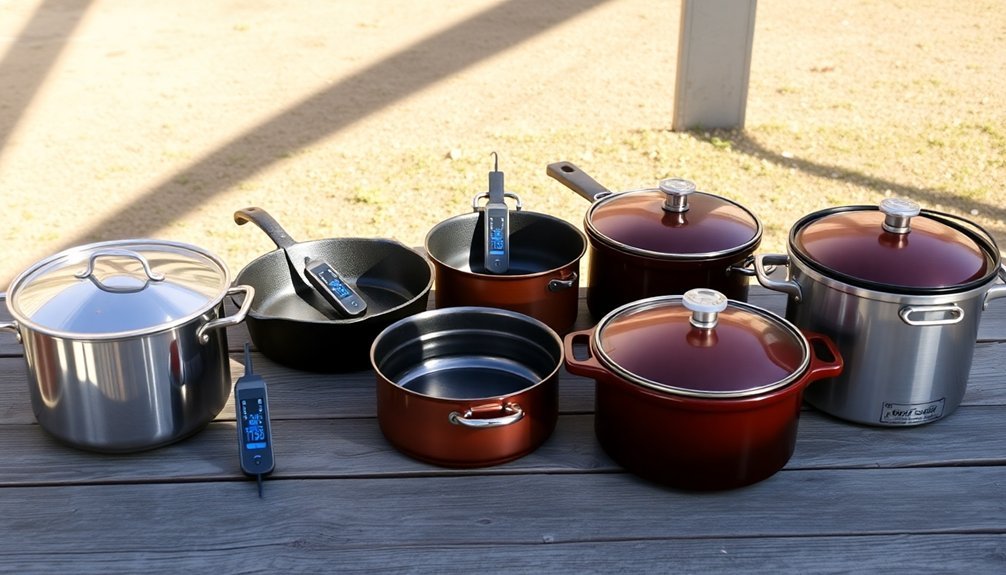
Several common materials excel at absorbing and retaining solar heat for cooking applications.
You'll find aluminum is particularly effective, absorbing heat faster than copper and reaching higher temperatures during peak sunlight hours. While it releases heat more quickly, aluminum's rapid heat absorption makes it ideal for quick cooking tasks.
If you're planning longer cooking sessions, consider materials with high thermal mass like cast iron. Though these take more time to heat up initially, they'll maintain cooking temperatures much longer, especially useful during cloudy periods or after sunset. Using black painted cookware can significantly improve heat absorption performance.
When choosing your cooking containers, you'll want to match the material to your cooking needs – aluminum for quick meals during peak sun hours, and high thermal mass materials like cast iron when you need sustained heat over extended periods.
Dark Containers for Maximum Efficiency
You'll find that dark metal containers are champions of heat absorption, making them ideal for cooking tasks that require quick temperature changes.
When you're choosing containers for solar cooking or oven use, darker surfaces will capture and transfer heat more effectively than their lighter counterparts.
The thermal conductivity rate of aluminum makes it particularly effective for quick heating and cooling in dark-colored cookware.
Your success with browning and even cooking depends greatly on the container's color, as dark metals can absorb and distribute heat up to 200 times more efficiently than light-colored materials like ceramic or Pyrex.
Dark Metals Absorb Heat
Dark metal containers stand at the forefront of heat-efficient cooking, absorbing thermal energy considerably faster than their lighter-colored counterparts.
You'll find that dark steel's thermal conductivity surpasses ceramic or Pyrex by 200 times, making it exceptionally efficient for heat transfer.
When you're using dark metal pans, you'll need to adjust your cooking approach. While they'll give you superior browning and crisping results, they can also lead to overcooked food if you're not careful.
These containers demonstrate rapid cooling rates despite their superior heat absorption capabilities.
To prevent this, you should reduce your oven temperature by 25 degrees Fahrenheit, especially in gas ovens where hot spots are common. You can also use foil or parchment paper to control browning.
Color Impacts Solar Cooking
When harnessing solar energy for cooking, the color of your containers plays an essential role in heat absorption efficiency. You'll want to choose dark-colored pots and pans, as they absorb all wavelengths of light and convert them into thermal energy.
Black surfaces are particularly effective at capturing and retaining heat from sunlight. For ideal results, use dark enamel or speckleware cookware in your solar cooker.
You can enhance performance by combining dark containers with reflective surfaces around them. While aluminum pots work well due to their thin metal composition, they should be dark-colored for maximum effectiveness.
If you're building a DIY solar oven, paint your containers black or use dark construction paper to improve heat absorption. Remember to pre-heat your setup by placing it in direct sunlight before cooking.
Pot Size and Shape Considerations
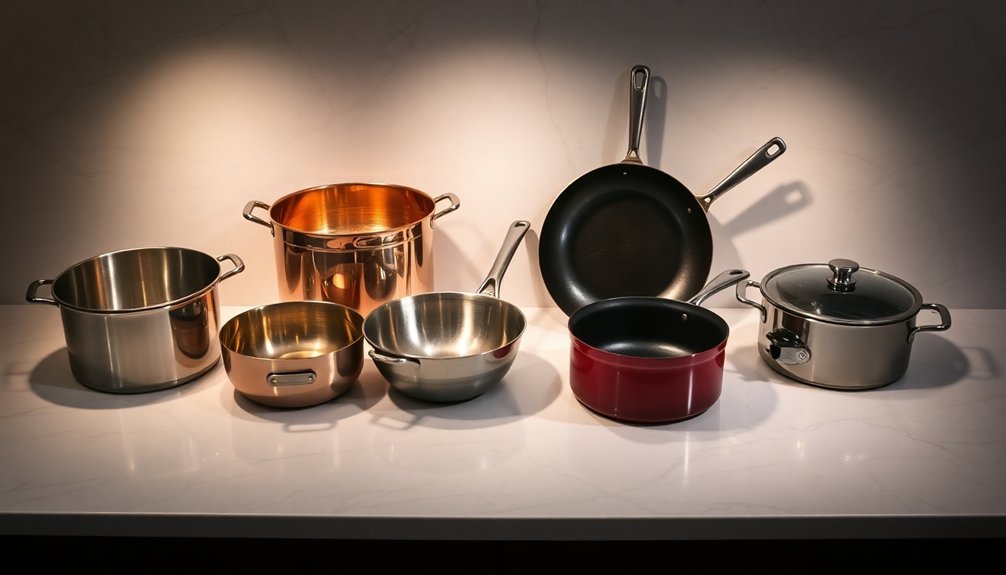
Your choice between wide and tall pots can greatly affect cooking performance, as wider pots distribute heat more quickly but lose it faster, while taller, narrower ones retain heat longer.
The shape of your pot directly influences heat distribution patterns, with wider bases promoting even heating across ingredients but requiring more energy to maintain temperature.
When selecting cooking vessels, you'll need to balance these factors against your specific needs, as wider designs can reduce cooking times for quick-heat dishes while narrower ones excel at slow-cooking methods that benefit from sustained heat retention.
Wide vs. Tall Designs
Choosing between wide and tall cooking containers involves critical trade-offs in stability, efficiency, and practicality.
Wide containers offer better stability and heating efficiency on larger stoves, as they prevent wasted heat up the sides. You'll find them particularly useful for browning and sautéing due to their shallow depth.
Tall containers, however, shine in portability and space optimization. They'll fit easily into backpack pockets and can store fuel canisters inside them while traveling.
You'll also notice they retain heat longer due to reduced surface area for evaporation. While wide pots excel in general cooking tasks, tall designs work best with integrated stove systems like Jetboil.
Consider your primary use – if you're cooking larger meals, go wide; if you're backpacking, tall containers might serve you better.
Heat Distribution Properties
Understanding heat distribution in cooking containers starts with the relationship between pot design and thermal efficiency. You'll get the best results with short, wide pots that maximize contact with your heat source. These designs spread heat more evenly across a larger surface area, which helps prevent hot spots and guarantees uniform cooking.
When choosing your cookware, pay attention to the materials. You'll want pots that combine high thermal diffusivity cores (like copper or aluminum) with durable stainless steel layers. This combination gives you quick, even heating while maintaining food safety.
Multi-ply designs are particularly effective, as they distribute heat efficiently from bottom to sides. Avoid disc-bottom pots, as they can create thermal discontinuity – meaning your food might burn at the bottom while remaining cool at the top.
Impact On Cooking Times
When selecting cookware for your kitchen, pot size and shape dramatically influence cooking times and efficiency.
Wide, shallow pots boil water faster than tall, narrow ones due to increased surface contact with heat. You'll find that larger pots work best for cooking multiple servings, while smaller ones heat up quickly for single portions or sauces.
- A 12-quart stockpot bubbling with aromatic soup for a family gathering
- A small 2-quart saucepan simmering a delicate cream sauce
- A wide, shallow pan quickly reducing a wine sauce to perfection
- A deep stock pot slowly developing rich flavors in a homemade broth
Match your pot size to your cooking task – use larger containers for batch cooking and smaller ones for quick-heating items.
Durability in Extreme Temperatures
The durability of cooking containers across extreme temperatures plays an essential role in their longevity and safety.
You'll find that metal cookware offers the highest heat tolerance, with carbon steel withstanding up to 1200°F, while stainless steel handles up to 800°F.
For plastic options, C-PET containers are remarkably heat-resistant up to 220°C and excel at blocking oxygen, making them perfect for microwave and convection ovens.
High-temperature plastic pans feature reinforced corners and can handle temperatures from -40°F to 375°F. They're especially useful with their antijam stacking design.
If you're looking for versatility, polypropylene containers provide excellent chemical and thermal resistance while maintaining transparency.
They're also highly recyclable and moisture-resistant, making them ideal for microwave use.
Safe Handling and Protection
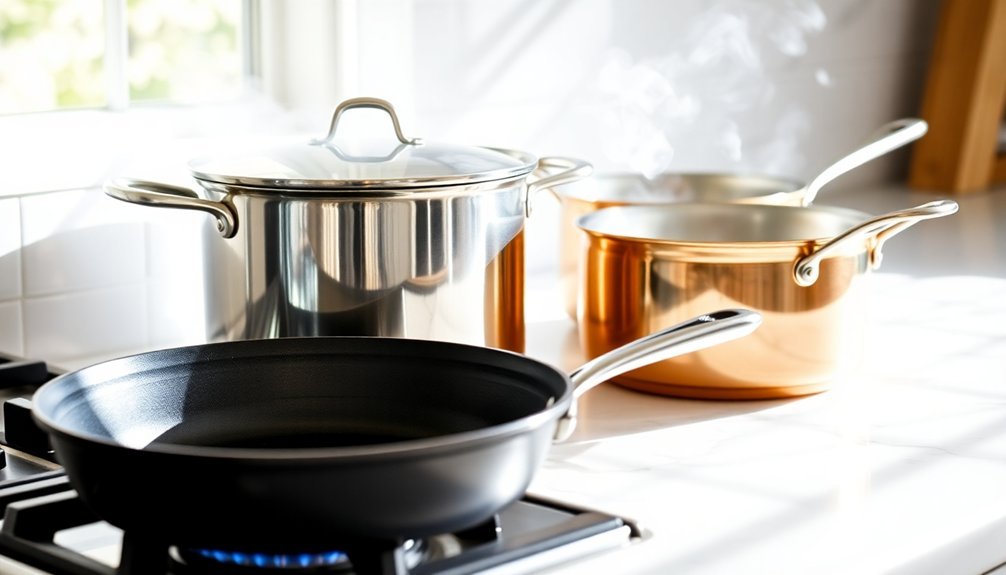
Proper handling techniques go hand-in-hand with heat-resistant materials to maximize both safety and longevity. When you're working with hot foods, always let them cool to room temperature before transferring to containers.
Make sure you select containers marked with appropriate safety labels, especially when using them in microwaves or with high-temperature foods.
- Picture yourself using pot holders while carefully moving hot pans away from the stove
- Visualize stacking containers with gentle precision, like building a stable tower
- Imagine thoroughly cleaning each corner and crevice until the container sparkles
- Think about inspecting containers under good light for any signs of wear or damage
Don't forget to check recycling codes, particularly favoring code 5 (polypropylene) for hot food storage, and always hand wash when possible to extend container life.
Heat Retention Properties
Understanding heat retention starts with the materials and design of your cooking containers.
You'll find that double-walled containers with air gaps and foam containers with tiny air pockets are highly effective at keeping your food hot. The key is their low thermal conductivity, which slows down heat transfer to the environment.
To maximize heat retention, you'll want to preheat your containers with boiling water for at least five minutes. This simple step can help maintain food temperatures above 60°C for nearly three hours.
When choosing containers, look for those with tight seals and snap-on lids to prevent heat from escaping. Some containers even feature small vents that let steam escape without compromising heat retention.
Materials like stainless steel and certain plastics offer both durability and reliable thermal performance.
Solar Cookware Maintenance
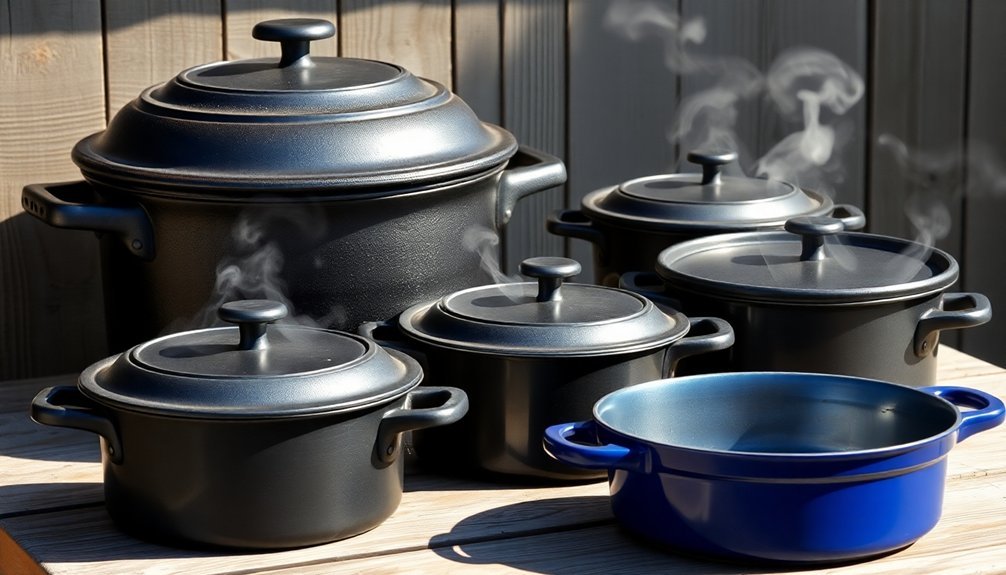
Maintaining your solar cookware goes hand in hand with its heat retention capabilities. You'll need to regularly inspect and clean your equipment to guarantee peak performance.
Always check for damage to the glazing and insulation, making sure seams remain tightly sealed with aluminum tape. When cleaning, be mindful of the plexiglass glazing's fit and adjust the tilt of your oven and reflector for maximum sunlight exposure.
- A shiny, well-maintained reflector surface that catches sunlight like a mirror
- A pristine plexiglass cover that lets sunlight through like a greenhouse window
- Tight seals that trap heat like a thermos keeping coffee hot
- Clean, black cookware surfaces that absorb heat like asphalt on a summer day
Remember to rotate your cooker every 20 minutes and use appropriate safety measures when handling hot containers.
Frequently Asked Questions
Can I Use My Regular Kitchen Containers for Heat-Based Cooking?
Not all kitchen containers are safe for heat. You'll need to check manufacturer labels for "microwave-safe" or "oven-safe" markings. Stick to glass, ceramic, and stainless steel containers specifically designed for heat-based cooking.
How Do Different Lid Materials Affect Cooking Temperature and Time?
Your lid choice considerably impacts cooking: stainless steel lids retain heat better and create tighter seals for faster cooking, while silicone lids offer moderate heat retention but are more flexible for various pot sizes.
Are Glass Containers More Likely to Break During Heat-Based Cooking?
You'll find that borosilicate and tempered glass containers rarely break during cooking if used properly. However, you must avoid sudden temperature changes and stick to manufacturer's temperature limits to prevent shattering.
Which Container Material Is Best for Cooking Acidic Foods?
You'll find stainless steel and enamel-coated cast iron are your best choices for cooking acidic foods. They're non-reactive, won't leach metallic flavors into your food, and maintain consistent heat distribution.
Does Container Color Affect Cooking Time in Different Weather Conditions?
No, container color's effect on cooking time isn't influenced by weather conditions. You'll still need to reduce temps by 25°F and check dark pans 5-10 minutes earlier, regardless of outside weather.
In Summary
When choosing containers for heat-based cooking, you'll get the best results with dark-colored, thick-walled pots made of cast iron, aluminum, or stainless steel. Remember to select containers that match your cooking needs in size and shape, and always use proper insulation when handling. With regular maintenance and careful storage, your heat-cooking containers will serve you efficiently for years of sustainable cooking adventures.

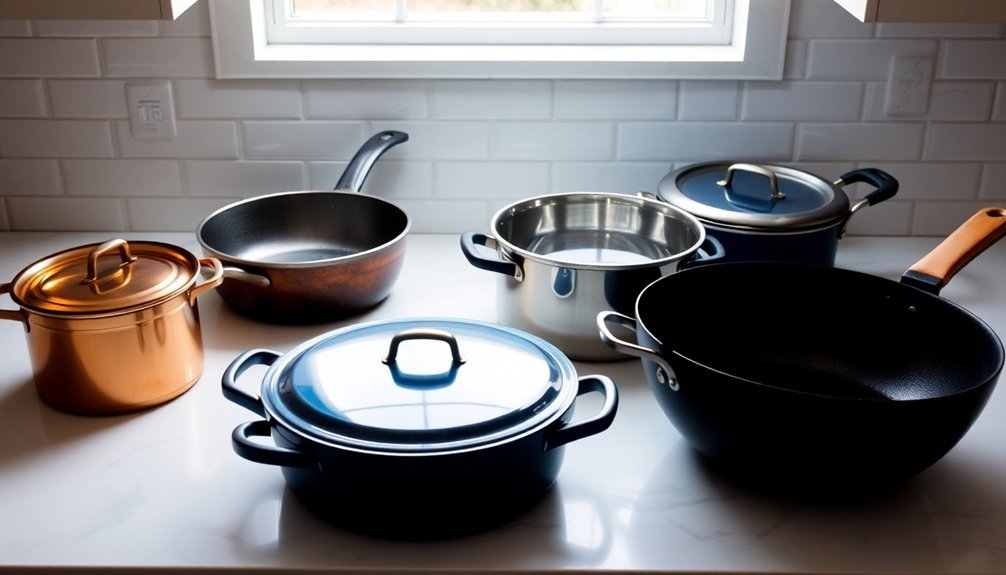
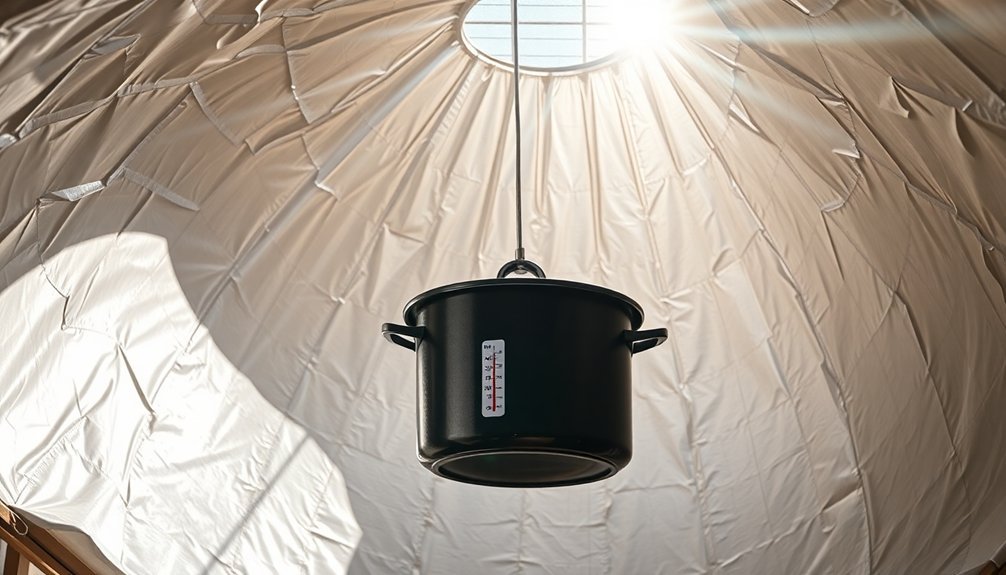

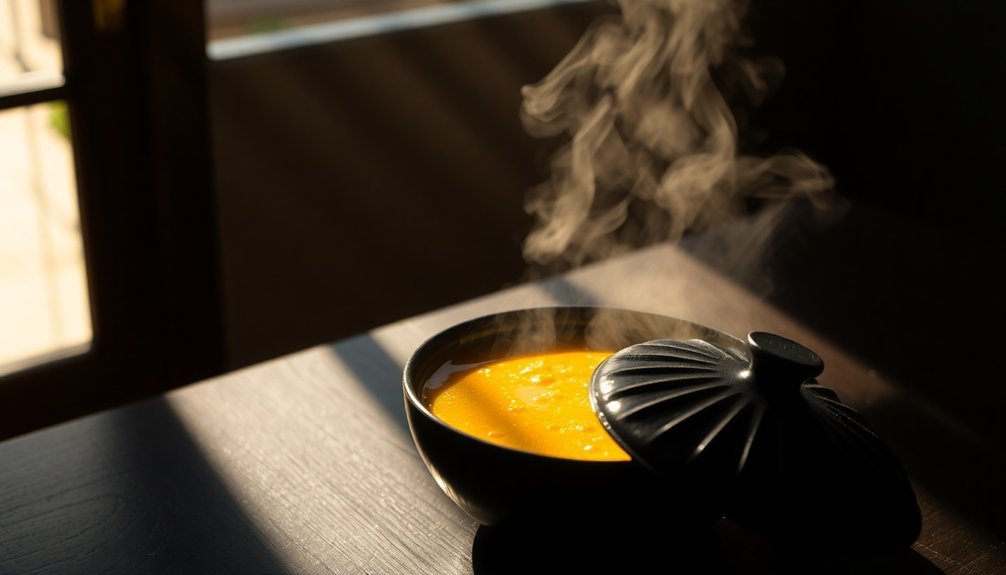
Leave a Reply